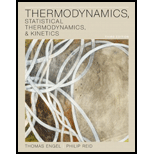
Interpretation: The value for the final temperature,
Concept Introduction: For ideal gas, the relation between
Where
Interpretation: The value for the final temperature,
Concept Introduction: For ideal gas, the relation between
Where
Want to see the full answer?
Check out a sample textbook solution
Chapter 2 Solutions
Thermodynamics, Statistical Thermodynamics, & Kinetics
- What is the finaltemperature of0.122 mole ofmonatomic ideal gas that performs 75J of work adiabatically if the initial temperature is 235C?arrow_forwardBenzoic acid, C6H5COOH, is a common standard used in bomb calorimeters, which maintain a constant volume. If 1.20 g of benzoic acid gives off 31, 723 J of energy when burned in the presence of excess oxygen and in a water bath having a temperature of 24.6 C, calculate q, w, H, and U for the reaction.arrow_forwardThe Dieterici equation of state for one mole of gas is p=RTe-aVRTV-b Where a and b are constants determined experimentally. For NH3g, a = 10.91 atm. L2 and b = 0.0401 L. Plot the pressure of the gas as the volume of 1.00 mol of NH3g expands from 22.4 L to 50.0 L at 273 K, and numerically determine the work done by the gas by measuring the area under the curve.arrow_forward
- The following are values of heat capacity for nitrogen gas; Temp K Cv J/mol. K 300 20.8 400 20.9 500 21.2 600 21.8 700 22.4 800 23.1 900 23.7 1000 24.3 1100 24.9 Using the general formula Cv = A BT C/T2, find values of A, B, and C that fit the given data.arrow_forwardWhat are the numerical values of the heat capacities c-v and c-p of a monatomic ideal gas,in units of cal/mol.K and L.atm/mol.K?arrow_forwardDetermine an expression for V/T p, n in terms of and . Does the sign on the expression make sense in terms of what you know happens to volume as temperature changes?arrow_forward
- 1.4 g of N2 are placed in a cylinder at an initial volume of 3.8 L and allowed to expand isothermally to a final volume of 10.8 liters against a constant external pressure of 0.8 bar. (A) Treating N2 as a perfect gas, find q, w, ΔU, ΔH, and ΔS for this process. (B) Now assume that the same process occurs, but that N2 can be assumed to have attractive forces between the molecules. In this case, how would q differ from the answer given in (A)? Specifically, would the value be larger, smaller, or unchanged? Explain your answer in 10 words or less. Can you please explain part a and b? <reference> Ne has a mass of 20.18 amu, N2 has a mass of 28.01 amu, H2 has a mass of 1.01 amu, Ar has a mass of 39.95 amu, and He has a mass of 4.00 amu.arrow_forwardKnowing that the molar heat capacity at constant pressure of CO₂ has the form Cp,m = (a + b + c/T²) J mol-¹K-¹, where a= 44.22, b= 8.79 x 10-³ K-¹, and c= -8.62 x 105 K 2,calculate how much heat can absorb 1.5 moles of this gas when the temperature is increased from 25°C to 150°C. NOTE: Give your answer in kJ mol-1arrow_forwardSuppose 2.00 mol of an ideal, monatomic gas is initially at a pressure of 3.00 atm and a temperature T = 350 K. It is expanded irreversibly and adiabatically (q = 0) against a constant external pressure of 1.00 atm until the volume has doubled. (a) Calculate the final volume. (b) Calculate w, q, and AU for this process, in joules. (c) Calculate the final temperature of the gas.arrow_forward
- (a) Suppose that attractions are the dominant interaction between gas molecules, and the equation of state is p = nRT/V – n2a/V2. Determine the work (W(non-ideal gas)) of reversible, isothermal expansion of such a gas from initial volume V (initial) = 20.0 L to final volume V(final) = 40.0 L if n = 2.00 mol, T = 300 K, and a = 3.621 atm-L2/mol2. Watch your units. (b)Determine the work (W(ideal gas) of reversible, isothermal expansion of an ideal gas from initial volume V (initial) = 20.0 L to final volume V(final) = 40.0 L if n = 2.00 mol and T = 300 K. (c) Show the difference W(non-ideal) – W(ideal). If all your calculations are done correctly, this result shows you the effect of attractive interaction between gas particles on the work done by the system.arrow_forwardgas undergoes an adiabatic expansion from 10 − 3 m 3 to 8 × 10 − 3 m 3 . The adiabatic line for the gas is given by P 3 V 5 = C (C is a constant). (a) Calculate the reversible work performed along the adiabatic line if the initial pressure is 10 5 P a and the initial volume = 10 − 3 m 3 . (b) What is the value of the constant C ? What is the unit of C ? (c) The gas reaches the final state in a two step process. An expansion at a constant initial pressure to the final volume followed by a decrease in pressure to the final volume 8 × 10 − 3 m 3 . What is the reversible work and heat in this process?arrow_forwardA sample of 3.0 moles of an ideal gas at 200 K and 200.0 kPa is compressed reversibly and adiabatically until the temperature reaches 250 K. Given the molar heat capacity at constant volume is 27.5 J K-1 mol-1, calculate q, w, delta U, delta H, the final pressure and the final volume. [0 J; 1.87 kJ; 1.87 kJ; 3.1112 kJ]arrow_forward
 Principles of Modern ChemistryChemistryISBN:9781305079113Author:David W. Oxtoby, H. Pat Gillis, Laurie J. ButlerPublisher:Cengage Learning
Principles of Modern ChemistryChemistryISBN:9781305079113Author:David W. Oxtoby, H. Pat Gillis, Laurie J. ButlerPublisher:Cengage Learning Physical ChemistryChemistryISBN:9781133958437Author:Ball, David W. (david Warren), BAER, TomasPublisher:Wadsworth Cengage Learning,
Physical ChemistryChemistryISBN:9781133958437Author:Ball, David W. (david Warren), BAER, TomasPublisher:Wadsworth Cengage Learning, Chemistry: The Molecular ScienceChemistryISBN:9781285199047Author:John W. Moore, Conrad L. StanitskiPublisher:Cengage Learning
Chemistry: The Molecular ScienceChemistryISBN:9781285199047Author:John W. Moore, Conrad L. StanitskiPublisher:Cengage Learning


